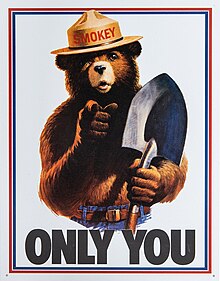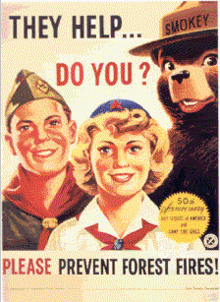Smokey Bear

Smokey Bear (often wrongly referred to as Smokey The Bear) is a character in the longest running public service campaign in United States history. The character's mission is to raise public awareness to protect American forests. Since the campaign's inception, the area lost annually has gone from 22,000,000 to 4,000,000 acres (16,000 km2).[1]
Smokey Bear's message "Only You Can Prevent Forest Fires" was created in 1944 by the Ad Council. In a recent study, 95% of those surveyed could finish the sentence when given the first words. In April 2001, Smokey's message was updated to "Only You Can Prevent Wildfires." [2]
Smokey's correct full name is Smokey Bear. In 1952, songwriters Steve Nelson and Jack Rollins had a hit with "Smokey The Bear". The pair said that "the" was added to Smokey’s name to keep the song's rhythm. This small change has caused confusion among Smokey fans ever since.[3] Note that, from the beginning, Smokey's name was intentionally spelled differently from the adjective smoky. The Forest Service emphatically denies that the name was ever "Smokey The Bear"; however, in the 1950s, that variant of the name became very widespread both in the popular imagination and in print, including at least one standard encyclopedia[4]. The campaign to remind the public of the correct version of the name is almost as old as the Smokey Bear campaign itself.
The fictional character Smokey Bear is administered by three entities: the United States Forest Service, the National Association of State Foresters, and the Ad Council. Smokey Bear's name and image are protected by U.S. federal law, the Smokey Bear Act of 1952 (16 U.S.C. 580 (p-2); 18 U.S.C. 711).[5]
Beginning the campaign

Before World War II, forest fire prevention campaigns used colorful posters to bring attention to the problem. During the war, images of the Axis powers of World War II leaders were depicted to drive home the message that forest fires hurt the country’s war effort. Lumber was a critical natural resource needed for the armed forces.[6]
On August 13, 1942, Disney's 5th full-length animated motion picture Bambi premiered in New York City. Soon after, Walt Disney allowed his characters to appear in fire prevention public service campaigns. However, 'Bambi' was only loaned to the government for a year, so a new symbol was needed.
Sticking with the popular animal theme, a bear was chosen. His name was inspired by "Smoky" Joe Martin, a New York City Fire Department hero who shrugged off burns and blindness in the bold 1922 rescue.[7]
Smokey's debut poster was released on August 9, 1944, which is considered his birthday. Overseen by the Cooperative Forest Fire Prevention Campaign, the first poster was illustrated by Albert Staehle. In it Smokey was depicted wearing jeans and a campaign hat, pouring a bucket of water on a campfire. The message underneath reads, "Smokey says – Care will prevent 9 out of 10 forest fires!"
In a 1948 poster, Smokey grasps a shovel, standing next to deer, squirrels, and birds. By now his message had been refined: "Another 30 million acres [120,000 km²] will burn this year – unless you are careful! Remember – only you can prevent forest fires!"
Beginning in 1944, the full-time campaign artist was Forest Service employee Rudy Wendelin, who was considered Smokey Bear's "caretaker" until he retired in 1973.
The living symbol of Smokey
The living symbol of Smokey Bear was an American black bear who in the spring of 1950 was caught in the Capitan Gap fire, a wildfire that burned 17,000 acres (69 km2) in the Capitan Mountains of New Mexico. The cub was in the Lincoln National Forest. Smokey had climbed a tree to escape the blaze, but his paws and hind legs had been burned. He was rescued by a Game Warden after the fire.
At first he was called Hotfoot Teddy, but was later renamed Smokey, after the mascot. A local rancher who had been helping fight the fire took the cub home with him, but he needed veterinary aid. New Mexico Department of Game and Fish Ranger Ray Bell took him to Santa Fe. His wife, Ruth, and their children, Don and Judy, cared for the cub. The story was picked up by the national news services and Smokey became an instant celebrity. He and the Bells were featured in Life, cementing his star status. Soon after, Smokey was flown in a Piper Cub to the National Zoo in Washington, D.C., where he lived for 26 years. Upon his death on November 9, 1976 [8], Smokey's remains were returned by the government to Capitan, New Mexico, and buried at what is now the Smokey Bear Historical Park [9].

Smokey the icon
Following the discovery of the living symbol of Smokey Bear, the character became a big part of American popular culture in the 1950s. He was on radio shows in the 1950s with his band, the Sons of the Pioneers. He appeared in comic strips and cartoons.
On the back of the song sheet was printed the Conservation Pledge:
I give my pledge as an American to save and faithfully to defend from waste the natural resources of my country – its soil and minerals, its forests, waters and wildlife.
In 1952, after Smokey Bear attracted considerable commercial interest, the Smokey Bear Act, an Act of Congress, was passed to take Smokey out of the public domain and place him under the control of the Secretary of Agriculture. The Act provided for the use of Smokey's royalties for continued education on forest fire prevention.
A Smokey Bear doll was released by Ideal Toys in 1952, which included a mail-in card for children to become junior forest rangers. Within three years half a million kids had applied. In April 1964, Smokey was given his own ZIP code, 20252. [2]
In 1955, the first children’s book was published, followed by many sequels and coloring books. Soon thousands of dolls, toys, and other collectibles were on the market.
During the 1950s and 1960s, the Ad Council sponsored radio ads, featuring Smokey Bear "in conversation" with prominent American celebrity stars such as Bing Crosby, Art Linkletter, Dinah Shore, Roy Rogers, and many others. [1]
Smokey also lends his name and image to the Smokey Bear Awards, which are awarded by the United States Forest Service:
"To recognize outstanding service in the prevention of wildland fires and to increase public recognition and awareness of the need for continuing fire prevention
efforts."[10]
Legacy

For Smokey’s 50th Anniversary in 1994, he was honored with a U.S. postage stamp that pictured a cub hanging onto a burned tree. It was illustrated by Rudy Wendelin.[2] The commercial for his 50th birthday portray woodland animals about to throw Smokey a surprise party with a cake with candles. When Smokey comes blindfolded, he smells smoke, not realizing it is birthday candles for his birthday. He uses his shovel to destroy the cake. When he takes off his blindfold, he sees that it was a birthday cake for him and apologizes. You can see the commercial here.
In 2004, Smokey celebrated his 60th Anniversary. According to Richard Earle, author of The Art of Cause Marketing, the Smokey Bear campaign is recognized as among the most powerful and enduring of all public service advertising. "Smokey is simple, strong, straightforward," Earle writes. "He's a denizen of those woods you're visiting, and he cares about preserving them. Anyone who grew up watching Bambi realizes how terrifying a forest fire can be. But Smokey wouldn't run away. Smokey's strong. He'll stay and fight the fire if necessary, but he'd rather have you douse it and cover it up so he doesn't have to."[11]
Voices of Smokey Bear
In current commercials featuring Smokey Bear, he is voiced by actorSam Elliott.
Adaptations
In 1950, Howard Wilkerson became the first Smokey bear in South Carolina. students from Hill City, South Dakota, helped stop a devastating wildfire that threatened their community. Afterwards the school district was allowed by the government to use Smokey Bear as its mascot. It is believed to be the only school in the country to be able to do so. [12]
Smokey Bear -- and parodies of the character -- have been appearing in animation for more than fifty years. In 1956, he made a cameo appearance in the Walt Disney short In the Bag with a voice provided by Washington Radio Station WMAL personality Jackson Weaver. Weaver served as the primary voice of Smokey - and following his death in October 1992, the "voice" of Smokey was retired until June of 2008 when the Forest Service launched a new series of PSA's, voiced by actor Sam Elliot, giving Smokey a new look designed to appeal to young adults. Others who provided a voice to Smokey prior to 1992, included Los Angeles Radio station KNX's George Walsh.
In 1966, Rankin/Bass produced an animated TV special called The Ballad of Smokey the Bear, narrated by James Cagney.
"The Ballad of Smokey the Bear" was covered by Canned Heat. The track is on their CD The Boogie House Tapes 1969-1999.
"Smokey the Bear Sutra", a 1969 poem by Gary Snyder which presents environmental concerns in the form of a Buddhist sutra, and depicts Smokey as the reincarnation of the Great Sun Buddha. Full text is on Wikisource - Smokey the Bear Sutra.

Environmentalism themed comics
Several other environmentalism, conservation or outdoor themed comics have appeared over the years including Mark Trail and Woodsy Owl.
References
- ^ a b Ad Council : Forest Fire Prevention - Smokey Bear (1944-Present)
- ^ a b c Northern Region - Centennial
- ^ Only You Can Prevent Wildfires. - Resources
- ^ World Book Encyclopedia, 1960 edition, "Fire Prevention" article
- ^ Smokey Bear Act of 1952
- ^ Smokey Bear
- ^ BOOKS OF THE TIMES; Their Battle Is Joined With an Inhuman Enemy by Ralph Blumenthal
- ^ http://nationalzoo.si.edu/Publications/ZooGoer/2002/6/smokey.cfm
- ^ www.smokeybearpark.com
- ^ http://www.symbols.gov/smokey/smokeybear-awards/2005/Fact_sheet.pdf
- ^ Richard Earle, The Art of Cause Marketing, New York: McGraw-Hill, 2000, page 230
- ^ The Story of the Hill City School Mascot
External links
- SmokeyBear.com
- A collection of Smokey Bear-related media
- U.S. Forest Service National Symbols Program
- Smokey Bear and Fire Prevention via US Forest Service
- Smokey Bear Historical Park in Capitan, New Mexico
- Fire causes - 2000 statistics
- Smokey Bear Days
- A collection of Smokey Bear and other forest fire-related posters
